maintenance MAZDA MODEL 3 HATCHBACK 2006 (in English) Owner's Guide
[x] Cancel search | Manufacturer: MAZDA, Model Year: 2006, Model line: MODEL 3 HATCHBACK, Model: MAZDA MODEL 3 HATCHBACK 2006Pages: 372, PDF Size: 5.55 MB
Page 269 of 372
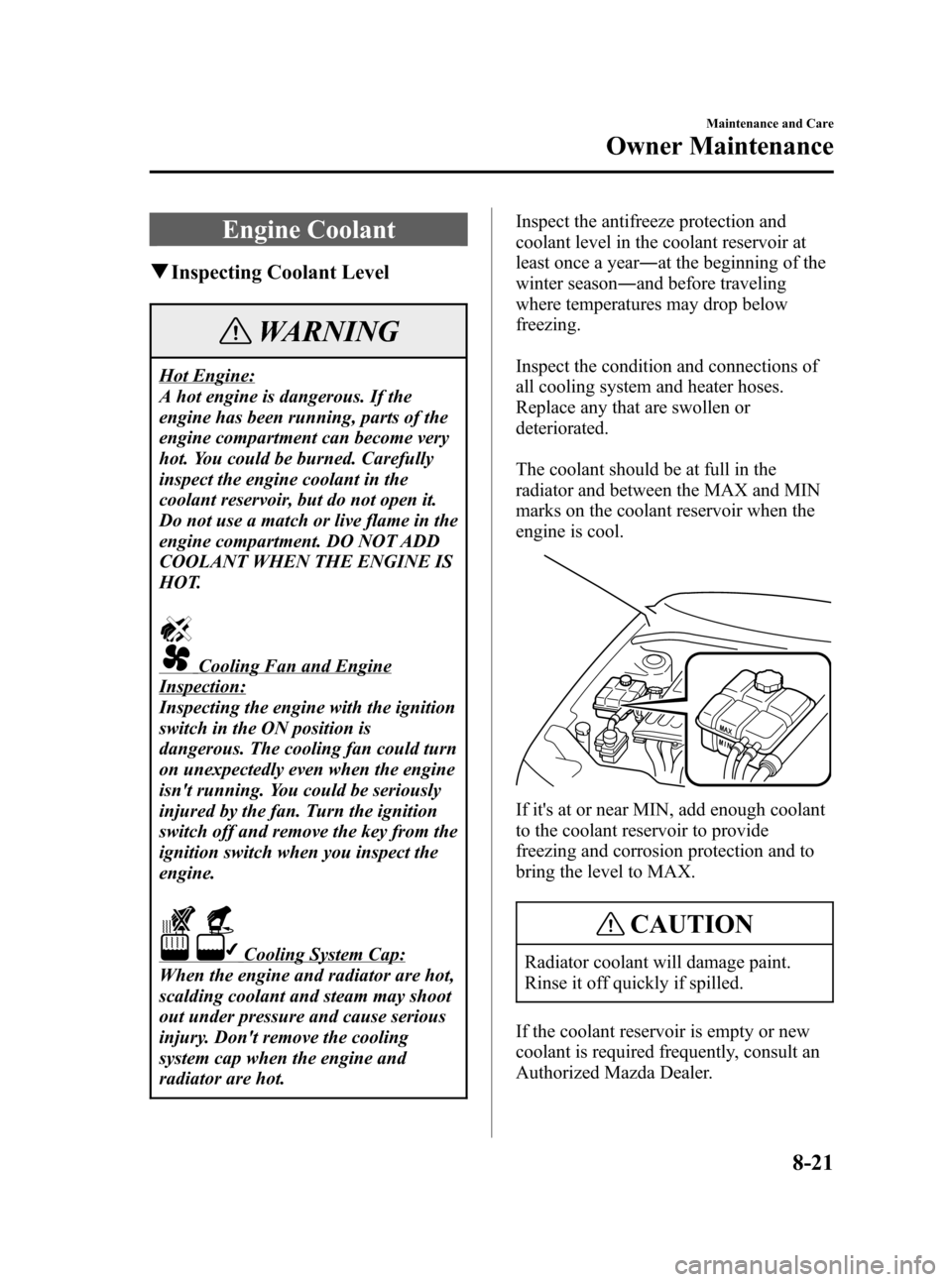
Black plate (269,1)
Engine Coolant
qInspecting Coolant Level
WARNING
Hot Engine:
A hot engine is dangerous. If the
engine has been running, parts of the
engine compartment can become very
hot. You could be burned. Carefully
inspect the engine coolant in the
coolant reservoir, but do not open it.
Do not use a match or live flame in the
engine compartment. DO NOT ADD
COOLANT WHEN THE ENGINE IS
HOT.
Cooling Fan and Engine
Inspection:
Inspecting the engine with the ignition
switch in the ON position is
dangerous. The cooling fan could turn
on unexpectedly even when the engine
isn't running. You could be seriously
injured by the fan. Turn the ignition
switch off and remove the key from the
ignition switch when you inspect the
engine.
Cooling System Cap:
When the engine and radiator are hot,
scalding coolant and steam may shoot
out under pressure and cause serious
injury. Don't remove the cooling
system cap when the engine and
radiator are hot.Inspect the antifreeze protection and
coolant level in the coolant reservoir at
least once a year―at the beginning of the
winter season―and before traveling
where temperatures may drop below
freezing.
Inspect the condition and connections of
all cooling system and heater hoses.
Replace any that are swollen or
deteriorated.
The coolant should be at full in the
radiator and between the MAX and MIN
marks on the coolant reservoir when the
engine is cool.
If it's at or near MIN, add enough coolant
to the coolant reservoir to provide
freezing and corrosion protection and to
bring the level to MAX.
CAUTION
Radiator coolant will damage paint.
Rinse it off quickly if spilled.
If the coolant reservoir is empty or new
coolant is required frequently, consult an
Authorized Mazda Dealer.
Maintenance and Care
Owner Maintenance
8-21
Mazda3_8U55-EA-05G_Edition2 Page269
Thursday, June 23 2005 2:56 PM
Form No.8U55-EA-05G
Page 270 of 372

Black plate (270,1)
qChanging Coolant
Change coolant according to Scheduled
Maintenance (page 8-3).
CAUTION
lUse only soft (demineralized) water
in the coolant mixture. Water that
contains minerals will cut down on
the coolant's effectiveness.
lDon't add only water. Always add a
proper coolant mixture.
lThe engine has aluminum parts and
must be protected by an ethylene-
glycol-based coolant to prevent
corrosion and freezing.
lDO NOT USE coolants Containing
Alcohol, methanol, Borate or
Silicate.
These coolants could damage the
cooling system.
lDO NOT MIX alcohol or methanol
with the coolant. This could damage
the cooling system.
lDon't use a solution that contains
more than 60% antifreeze.
This would reduce effectiveness.
NOTE
If the“FL22”mark is shown on or near
the cooling system cap, use FL22 type
engine coolant. If engine coolant other
than FL22 type is used, the engine
coolant must be replaced earlier than
the specified replacement interval
indicated in the scheduled maintenance
(page 8-3).
Except FL22 type
For mixture percentage:
ProtectionVolume
Antifreeze
solutionDeminera-
lized water
Above_
16°C (3°F) 35% 65%
Above_
26°C (_
15°F) 45% 55%
Above_
40°C (_
40°F) 55% 45%
FL22 type
FL22 type engine coolant concentration is
factory adjusted. Use the product as it is
without diluting it.
8-22
Maintenance and Care
Owner Maintenance
Mazda3_8U55-EA-05G_Edition2 Page270
Thursday, June 23 2005 2:56 PM
Form No.8U55-EA-05G
Page 271 of 372
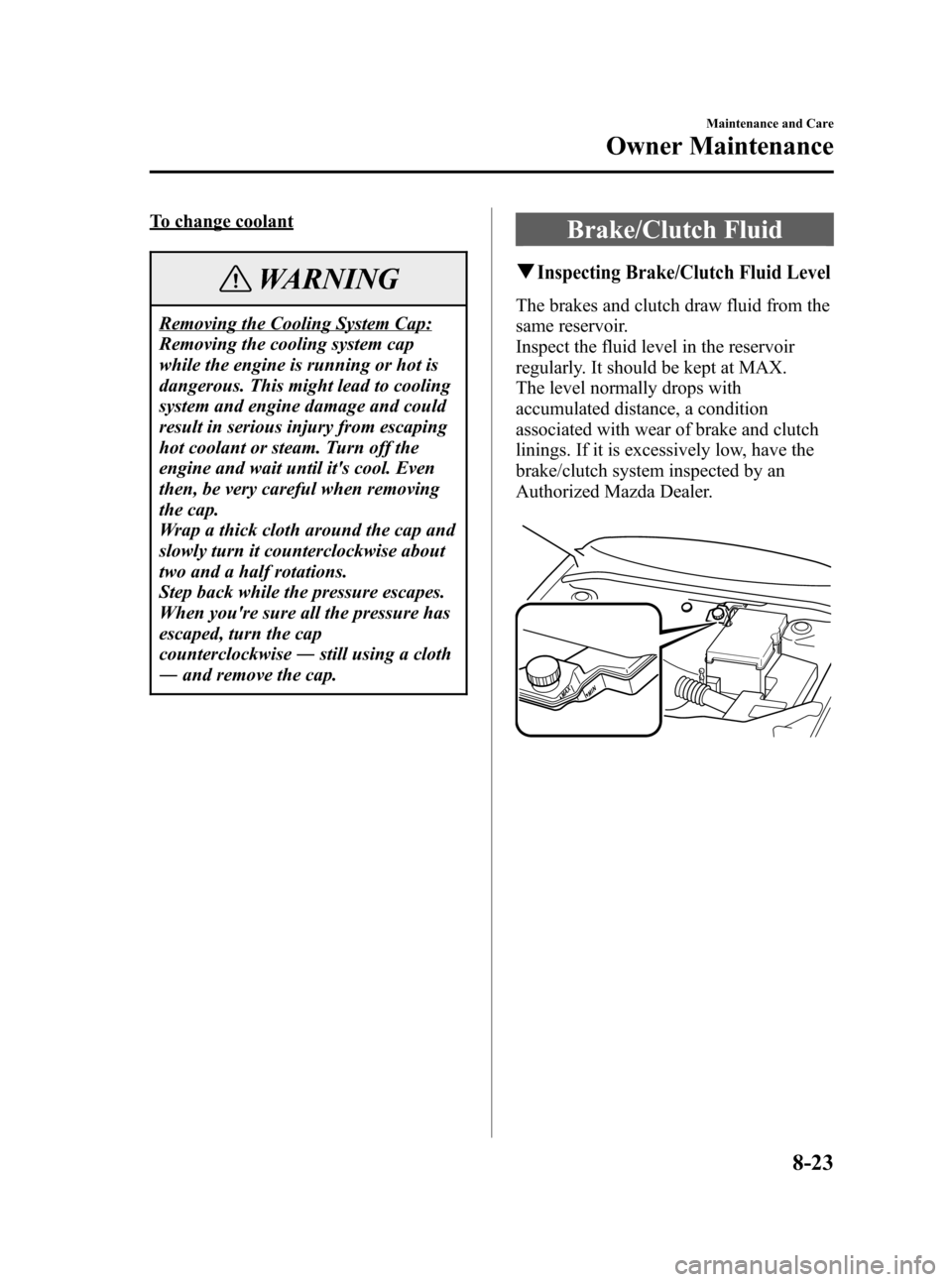
Black plate (271,1)
To change coolant
WARNING
Removing the Cooling System Cap:
Removing the cooling system cap
while the engine is running or hot is
dangerous. This might lead to cooling
system and engine damage and could
result in serious injury from escaping
hot coolant or steam. Turn off the
engine and wait until it's cool. Even
then, be very careful when removing
the cap.
Wrap a thick cloth around the cap and
slowly turn it counterclockwise about
two and a half rotations.
Step back while the pressure escapes.
When you're sure all the pressure has
escaped, turn the cap
counterclockwise―still using a cloth
―and remove the cap.
Brake/Clutch Fluid
qInspecting Brake/Clutch Fluid Level
The brakes and clutch draw fluid from the
same reservoir.
Inspect the fluid level in the reservoir
regularly. It should be kept at MAX.
The level normally drops with
accumulated distance, a condition
associated with wear of brake and clutch
linings. If it is excessively low, have the
brake/clutch system inspected by an
Authorized Mazda Dealer.
Maintenance and Care
Owner Maintenance
8-23
Mazda3_8U55-EA-05G_Edition2 Page271
Thursday, June 23 2005 2:56 PM
Form No.8U55-EA-05G
Page 272 of 372

Black plate (272,1)
qAdding Brake/Clutch Fluid
WARNING
Spilled Brake Fluid:
Spilled brake fluid is dangerous. If it
gets in your eyes, they could be
seriously injured. If this happens,
immediately flush your eyes with water
and get medical attention. Brake fluid
spilled on a hot engine could cause a
fire. Be careful not to spill brake fluid
on yourself or on the engine.
Low Brake/Clutch Fluid Levels:
Low brake/clutch fluid levels are
dangerous. Low levels could signal
brake lining wear or a brake system
leak. Your brakes could fail and cause
an accident. If you find a low fluid
level, have the brakes and clutch
inspected.
If the fluid level is low, add fluid until it
reaches MAX.
Before adding fluid, thoroughly clean the
area around the cap.
CAUTION
lBrake and clutch fluid will damage
painted surfaces. If brake or clutch
fluid does get on a painted surface,
wipe it off immediately.
lUsing nonspecified brake and clutch
fluids (page 10-4) will damage the
systems. Mixing different fluids will
also damage them.
If the brake/clutch system frequently
requires new fluid, consult an
Authorized Mazda Dealer.
Power Steering Fluid
qInspecting Power Steering Fluid
Level
CAUTION
To avoid damage to the power steering
pump, don't operate the vehicle for long
periods when the power steering fluid
level is low.
NOTE
Use specified power steering fluid
(page 10-4).
Inspect the fluid level in the reservoir at
each engine oil change with the engine off
and cold. Add fluid if necessary; it does
not require periodic changing.
The level must be kept between MIN and
MAX.
Visually examine the lines and hoses for
leaks and damage.
If new fluid is required frequently, consult
an Authorized Mazda Dealer.
8-24
Maintenance and Care
Owner Maintenance
Mazda3_8U55-EA-05G_Edition2 Page272
Thursday, June 23 2005 2:56 PM
Form No.8U55-EA-05G
Page 273 of 372

Black plate (273,1)
Automatic Transaxle Fluid
(ATF)
qInspecting Automatic Transaxle
Fluid Level
The automatic transaxle fluid level should
be inspected regularly. Measure it as
described below.
2.3-liter engine
CAUTION
lAlways check the automatic
transaxle fluid level according to the
following procedure. If the
procedure is not done correctly, the
automatic transaxle fluid level
cannot be measured accurately
which could lead to automatic
transaxle damage.
lA low fluid level can cause transaxle
slippage. Overfilling can cause
foaming, loss of fluid, and transaxle
malfunction.
lUse only the specified fluid. A non-
specified fluid could result in
transaxle malfunction and failure.
1. Park on a level surface and set the
parking brake firmly.
2. Make sure there is no ATF leakage
from the ATF hose or the housing.
3. Shift the shift lever to the park position
(P), start the engine and warm it up.
CAUTION
Do not shift the shift lever while the
engine is warming up. If the ATF level
is extremely low, the automatic
transaxle could be damaged.
4. While the engine is still idling, pull out
the dipstick and wipe it clean, and then
put it back.
5. Check the ATF level. If there is no ATF
adhering 5 mm from the end of the
dipstick, add ATF.
CAUTION
If there is no ATF adhering to the
dipstick even after the engine has been
warmed up, do not drive the vehicle.
Otherwise, the automatic transaxle
could be damaged.
6. Shift the shift lever to each range and
position, and make sure there is no
abnormality.
7. Drive the vehicle on city roads for 5
km (3.1 mile) or more.
8. Park on a level surface and set the
parking brake firmly.
Maintenance and Care
Owner Maintenance
8-25
Mazda3_8U55-EA-05G_Edition2 Page273
Thursday, June 23 2005 2:56 PM
Form No.8U55-EA-05G
Page 274 of 372

Black plate (274,1)
9. Shift the shift lever to the park position
(P), check the ATF level while the
engine is idling, and make sure that the
ATF level is within the proper level. If
the ATF level is not within the proper
level, add ATF.
The proper fluid level is marked on the
dipstick as follows.
Full
OK
Low
2.0-liter engine
The volume of fluid changes with the
temperature. Fluid must be checked at idle
without driving at normal operating
temperature.
CAUTION
lLow fluid level causes transaxle
slippage. Overfilling can cause
foaming, loss of fluid, and transaxle
malfunction.
lUse specified fluid (page 10-4). A
nonspecified fluid could result in
transaxle malfunction and failure.
1. Park on a level surface and set the
parking brake firmly.
2. Start the engine and depress the brake
pedal.3. Move the shift lever through all ranges
and set it at P.
WARNING
Sudden Vehicle Movement:
Shifting the shift lever without first
depressing the brake pedal is
dangerous. The vehicle could move
suddenly and cause an accident.
Make sure the brake pedal is applied
before shifting the shift lever.
4. With the engine still idling, pull out the
dipstick, wipe it clean, and put it back.
5. Pull it out again.
The proper fluid level is marked on the
dipstick as follows.
Full
A
LowFull
B
Low
Fluid hot scale A
When the vehicle has been driven and the
fluid is at normal operating temperature,
about 65°C (150°F), the level must be
between Full and Low.
8-26
Maintenance and Care
Owner Maintenance
Mazda3_8U55-EA-05G_Edition2 Page274
Thursday, June 23 2005 2:56 PM
Form No.8U55-EA-05G
Page 275 of 372
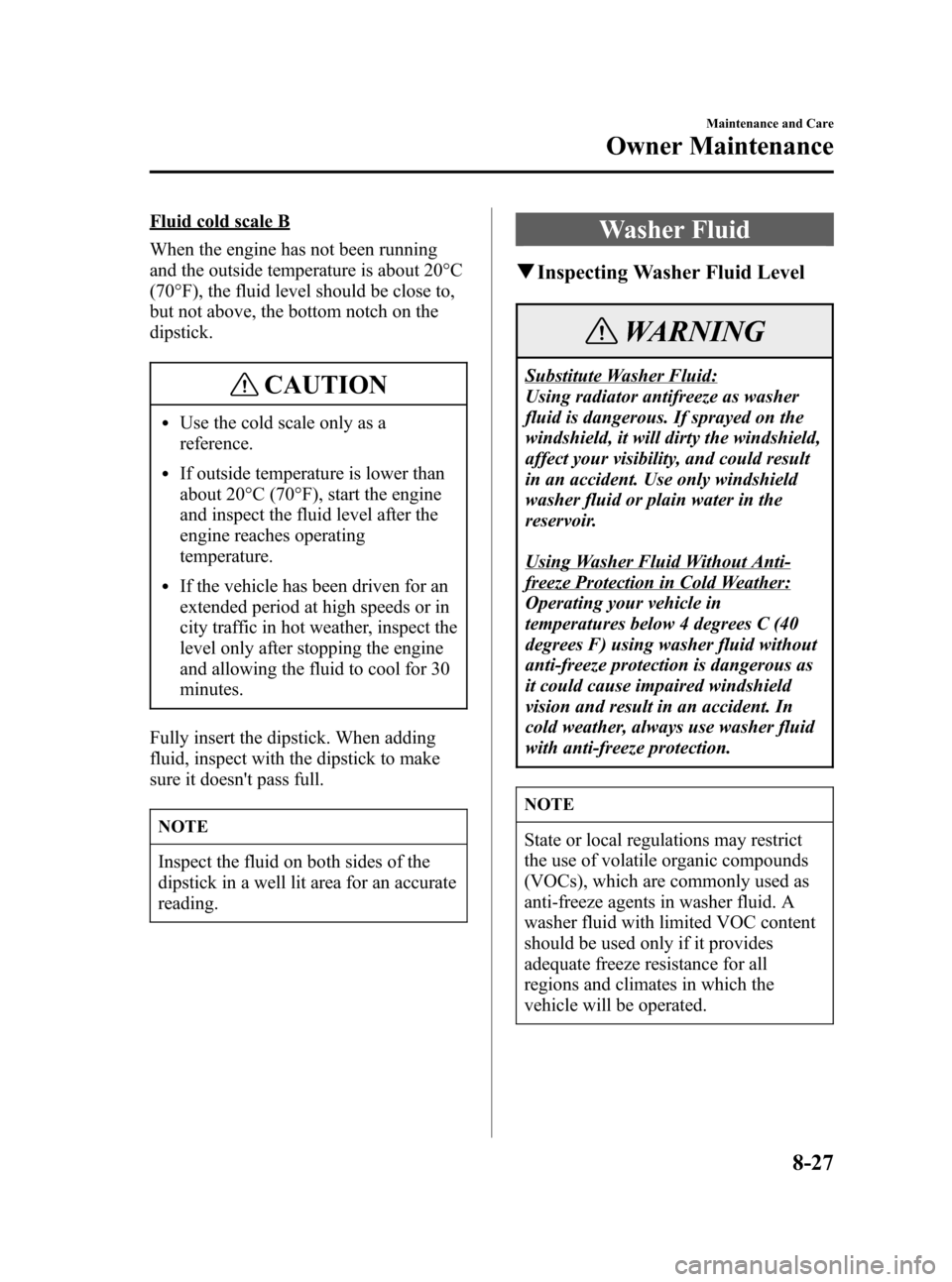
Black plate (275,1)
Fluid cold scale B
When the engine has not been running
and the outside temperature is about 20°C
(70°F), the fluid level should be close to,
but not above, the bottom notch on the
dipstick.
CAUTION
lUse the cold scale only as a
reference.
lIf outside temperature is lower than
about 20°C (70°F), start the engine
and inspect the fluid level after the
engine reaches operating
temperature.
lIf the vehicle has been driven for an
extended period at high speeds or in
city traffic in hot weather, inspect the
level only after stopping the engine
and allowing the fluid to cool for 30
minutes.
Fully insert the dipstick. When adding
fluid, inspect with the dipstick to make
sure it doesn't pass full.
NOTE
Inspect the fluid on both sides of the
dipstick in a well lit area for an accurate
reading.
Washer Fluid
qInspecting Washer Fluid Level
WARNING
Substitute Washer Fluid:
Using radiator antifreeze as washer
fluid is dangerous. If sprayed on the
windshield, it will dirty the windshield,
affect your visibility, and could result
in an accident. Use only windshield
washer fluid or plain water in the
reservoir.
Using Washer Fluid Without Anti-
freeze Protection in Cold Weather:
Operating your vehicle in
temperatures below 4 degrees C (40
degrees F) using washer fluid without
anti-freeze protection is dangerous as
it could cause impaired windshield
vision and result in an accident. In
cold weather, always use washer fluid
with anti-freeze protection.
NOTE
State or local regulations may restrict
the use of volatile organic compounds
(VOCs), which are commonly used as
anti-freeze agents in washer fluid. A
washer fluid with limited VOC content
should be used only if it provides
adequate freeze resistance for all
regions and climates in which the
vehicle will be operated.
Maintenance and Care
Owner Maintenance
8-27
Mazda3_8U55-EA-05G_Edition2 Page275
Thursday, June 23 2005 2:56 PM
Form No.8U55-EA-05G
Page 276 of 372
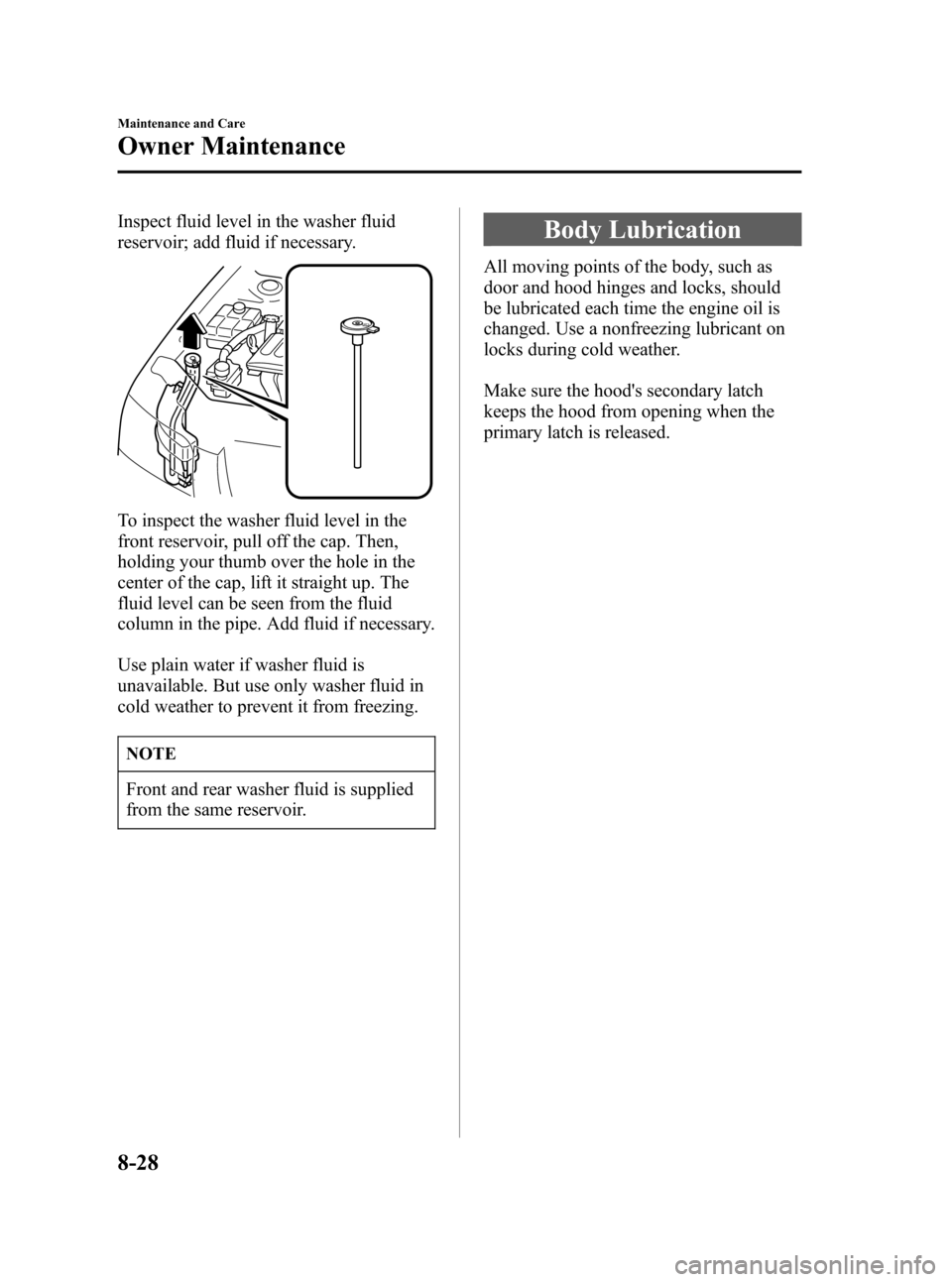
Black plate (276,1)
Inspect fluid level in the washer fluid
reservoir; add fluid if necessary.
To inspect the washer fluid level in the
front reservoir, pull off the cap. Then,
holding your thumb over the hole in the
center of the cap, lift it straight up. The
fluid level can be seen from the fluid
column in the pipe. Add fluid if necessary.
Use plain water if washer fluid is
unavailable. But use only washer fluid in
cold weather to prevent it from freezing.
NOTE
Front and rear washer fluid is supplied
from the same reservoir.
Body Lubrication
All moving points of the body, such as
door and hood hinges and locks, should
be lubricated each time the engine oil is
changed. Use a nonfreezing lubricant on
locks during cold weather.
Make sure the hood's secondary latch
keeps the hood from opening when the
primary latch is released.
8-28
Maintenance and Care
Owner Maintenance
Mazda3_8U55-EA-05G_Edition2 Page276
Thursday, June 23 2005 2:56 PM
Form No.8U55-EA-05G
Page 277 of 372

Black plate (277,1)
Air Filter
CAUTION
Don't drive without an air filter. This
could result in excessive engine wear.
This air filter may be cleaned with
compressed air and reused, or replaced,
depending on its condition. Unless it is
very dirty, simply shake it to remove
foreign particles. Each time you inspect it,
wipe inside the air cleaner housing with a
damp cloth.
qReplacing the Air Filter
NOTE
If the vehicle is operated in very dusty
or sandy areas, replace the filter more
often than the recommended intervals.
CAUTION
Use a Mazda genuine air filter. Use of
other filters could damage the airflow
sensor.1. Make sure the ignition switch is turned
off.
2. Remove the battery cover and battery
duct.
Battery duct
Battery cover
3. Unfasten the clamps.
4. Lift off the air filter cover and remove
the filter.
Air filter cover
Air filter
Maintenance and Care
Owner Maintenance
8-29
Mazda3_8U55-EA-05G_Edition2 Page277
Thursday, June 23 2005 2:56 PM
Form No.8U55-EA-05G
Page 278 of 372
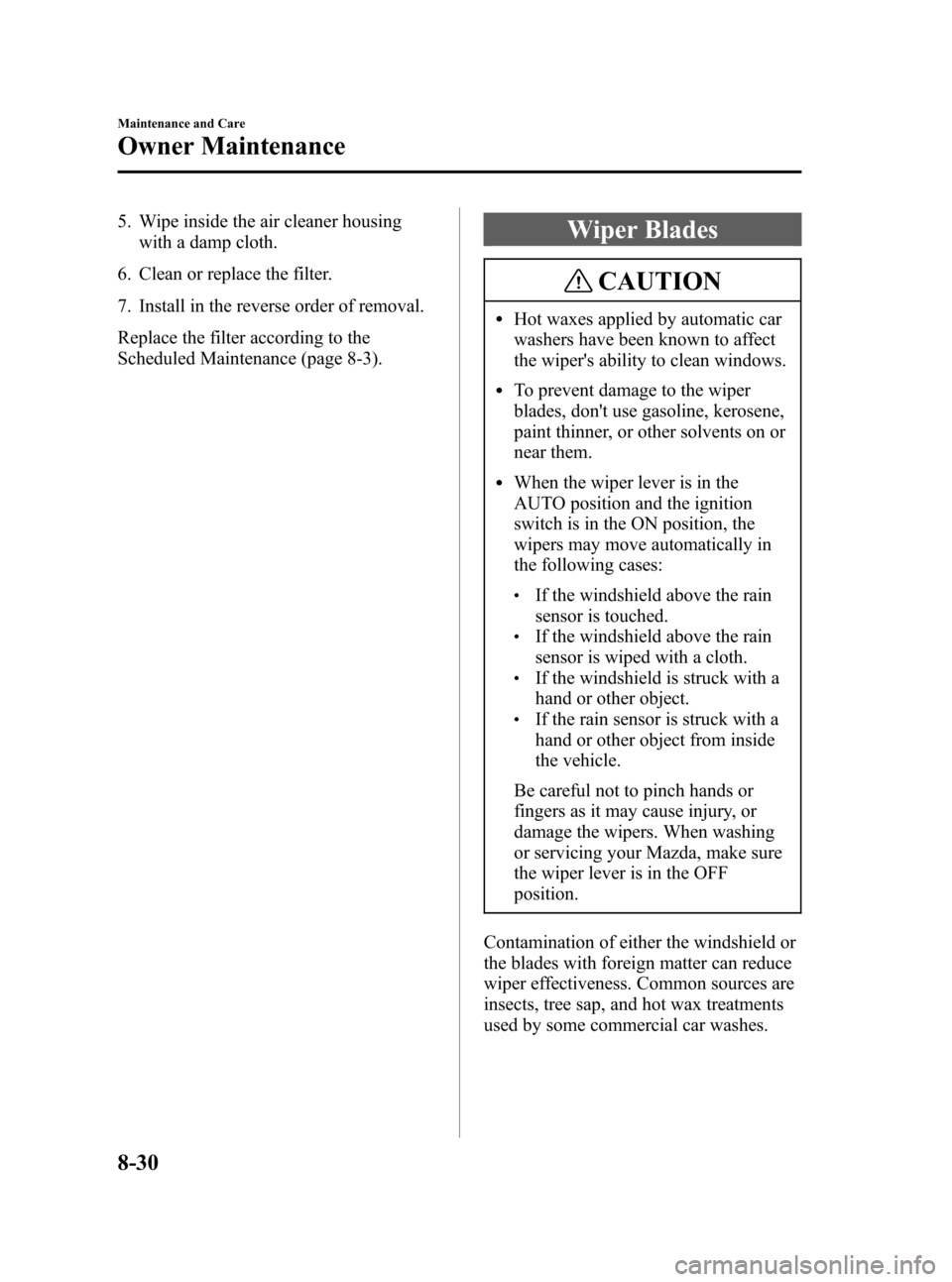
Black plate (278,1)
5. Wipe inside the air cleaner housing
with a damp cloth.
6. Clean or replace the filter.
7. Install in the reverse order of removal.
Replace the filter according to the
Scheduled Maintenance (page 8-3).Wiper Blades
CAUTION
lHot waxes applied by automatic car
washers have been known to affect
the wiper's ability to clean windows.
lTo prevent damage to the wiper
blades, don't use gasoline, kerosene,
paint thinner, or other solvents on or
near them.
lWhen the wiper lever is in the
AUTO position and the ignition
switch is in the ON position, the
wipers may move automatically in
the following cases:
lIf the windshield above the rain
sensor is touched.
lIf the windshield above the rain
sensor is wiped with a cloth.
lIf the windshield is struck with a
hand or other object.
lIf the rain sensor is struck with a
hand or other object from inside
the vehicle.
Be careful not to pinch hands or
fingers as it may cause injury, or
damage the wipers. When washing
or servicing your Mazda, make sure
the wiper lever is in the OFF
position.
Contamination of either the windshield or
the blades with foreign matter can reduce
wiper effectiveness. Common sources are
insects, tree sap, and hot wax treatments
used by some commercial car washes.
8-30
Maintenance and Care
Owner Maintenance
Mazda3_8U55-EA-05G_Edition2 Page278
Thursday, June 23 2005 2:56 PM
Form No.8U55-EA-05G